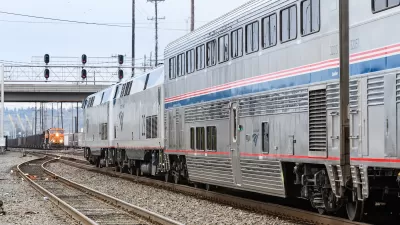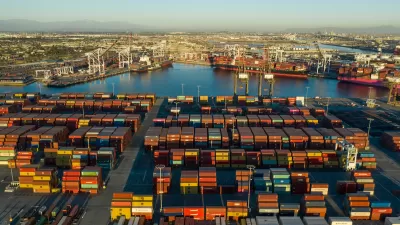A new study suggests that getting freight onto trains and off of trucks would have a significant impact on traffic.
"Moving freight by rail has the potential to save Americans hundreds of dollars and time in the car, according to the Congestion Relief Index, a study of traffic congestion in 82 major urban areas.
"With gas prices at an all-time high, Americans can't afford to waste money and time sitting in traffic. Because one intermodal train can take nearly 300 trucks off our highways, shifting freight from trucks to trains reduces competition between commuters, drivers and freight traffic for space on the road," said Wendell Cox, author of the study and principal of Demographia, a market research and urban policy consultancy.
The study claims that if 25% of the volume moved by trucks was moved to rail transport by the year 2026, each American commuter could save, on average, $985 -- and 41 hours of time in their car -- a year. The survey also estimates that each year, a commuter could save 79 gallons of fuel and reduce air pollution by 920,000 tons."
FULL STORY: Study: Freight rail can reduce traffic congestion

Planetizen Federal Action Tracker
A weekly monitor of how Trump’s orders and actions are impacting planners and planning in America.

Restaurant Patios Were a Pandemic Win — Why Were They so Hard to Keep?
Social distancing requirements and changes in travel patterns prompted cities to pilot new uses for street and sidewalk space. Then it got complicated.

Map: Where Senate Republicans Want to Sell Your Public Lands
For public land advocates, the Senate Republicans’ proposal to sell millions of acres of public land in the West is “the biggest fight of their careers.”

Maui's Vacation Rental Debate Turns Ugly
Verbal attacks, misinformation campaigns and fistfights plague a high-stakes debate to convert thousands of vacation rentals into long-term housing.

San Francisco Suspends Traffic Calming Amidst Record Deaths
Citing “a challenging fiscal landscape,” the city will cease the program on the heels of 42 traffic deaths, including 24 pedestrians.

California Homeless Arrests, Citations Spike After Ruling
An investigation reveals that anti-homeless actions increased up to 500% after Grants Pass v. Johnson — even in cities claiming no policy change.
Urban Design for Planners 1: Software Tools
This six-course series explores essential urban design concepts using open source software and equips planners with the tools they need to participate fully in the urban design process.
Planning for Universal Design
Learn the tools for implementing Universal Design in planning regulations.
Heyer Gruel & Associates PA
JM Goldson LLC
Custer County Colorado
City of Camden Redevelopment Agency
City of Astoria
Transportation Research & Education Center (TREC) at Portland State University
Camden Redevelopment Agency
City of Claremont
Municipality of Princeton (NJ)





























